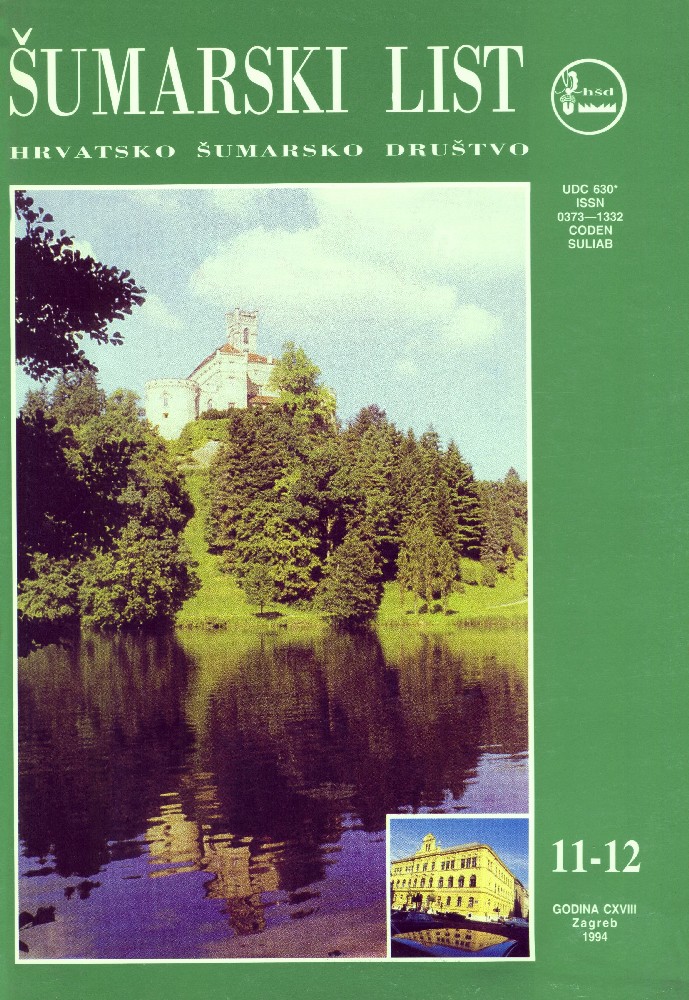
broj: 11-12/1994
pdf (14,0 MB) |
|
||||||||||||||
| PREGLEDNI ČLANCI | ||
| Piškorić, O. | UDK 630* 902.1 | |
| ANTUN TOMIĆ, 1803-1894. - First Presedent of the Croatian Forestry Society pdf HR EN | 331 | |
| IZVORNI ZNANSTVENI ČLANCI | ||
| Jurković, M. | UDK 630* 235.2 (egzote) | |
| New Species of Dendroflora introduced to the Region of Croatia pdf HR EN | 339 | |
| PRETHODNO PRIOPĆENJE | ||
| Medvedović, J. | UDK 630* 18.581.5 : 111.88 | |
| Forest Climate and Phytomass of the Ground Layer in one Part of the Samobor Mountains pdf HR EN | 349 | |
| Summary: Microclimatic and floral research was carried out in the mountain range of Samoborsko Gorje, the area called »Tepec«, in a forest of the sessile-flowered oak with black hornbeam (Querco-Ostryetum carpinifoliae Ht. 1938), and in a forest of beech with black hornbeam (Ostryo-Fagetum sylvaticae Wraber 1968). The measurements have shown, that, compared to the morning temperatures in the city of Samobor, those in the sessileflowered forest were by 2.6°C higher, and in the beech forest by 0.9°C. The midday temperatures were lower by 1.3°C and 2.8°C resp., and the evening values were also lower by 0.9°C and 0.TC respectively. Other values of the microclimate were also considerably different, both according to the figures and the dynamics of their changing. Besides the standard measurements of the microclimatic values, the temperature of the forest tree trunks was also measured. For now it is not quite certain what the obtained data mean, though the ones from other research objects indicate, that the trunk temperature of vital trees rather depends on the soil temperature, while the temperature of the air has a stronger impact upon the less vital trees. If this discovery is confirmed with a greater number of samples, by means of the air-trunk-soil relation, it will be possible in the future to establish the vitality of trees, i. e. the activity of the conducting system and photosynthesis. The data from Samoborsko Gorje will then also be used. The floral composition was investigated on the profiles; at a distance of 10 m within the profile, 1 m2-phytocenological samples were lain for determination of the plant mass of the low-growth layer above ground. On the profiles shown on the map, scale 1:5000 (Map 1), there were recorded and counted 53 plant species, 27 in the beech forest. Upon 1 m2 are there are round 45.6 plant pieces, 15.7 in the beech forest. The fresh plant mass weighed 215,82 glm in the oak forest, 45,64 glm2 in the beech forest. Dried mass was 50.23 and 36.40 glm2 respectively; in the beech forest it was 10.40 and 7.73 glm2 resp. The proportion of the plant species in the oak and beech forest was 2:1; there were 2.9:1 pieces on one square metre; the proportion of the mass is 4.79:1 in fresh state, 4.83:1 in air-dried state, and 4.71:1 in the state after being dried at 105°C. The conclusion is, that the plant mass of the crop plants in the low-growth layer of the sessile-flowered oak several times bigger than the mass in the beech forest. This is due to the heliophile properties of the oak forests, and the schiophile properties of the beech forests. It was important to establish how big these differences are. Due to the small number of the samples (34), it is impossible to determine the mass on the hectare. In further research this number will increase. The results of the measurements will be used in the research on the difference between the general climate and the forest microclimate. They will also be applied to the research on the impact of the climate on forest vegetation and vitality. The information on the number and mass of the crop plants may be useful in determining the food potentials for the wild animals in particular forest associations. Key words: microclimate; phytomass; forest association | ||
| STRUČNI ČLANCI | ||
| Vojinović, M., Miočić, D. | UDK 630* 151.7/8 (Dama dama) | |
| Investigation of Fallow on the Badija Island pdf HR EN | 357 | |


